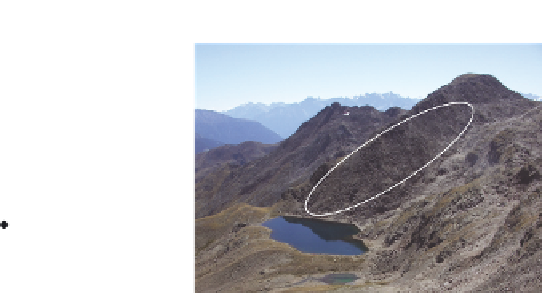Geoscience Reference
In-Depth Information
(a)
(b)
400
Conductivity
200
RAS
SOS
30
15
0
1985
1990
1995
2000
2005
Figure 3.16
(a) Conductivity in two alpine lakes in the period 1985-2005, Rasass See
(RAS: triangles) and Schwarzsee ob Sölden (SOS: circles). Horizontal dotted line indicates
a break in the vertical
y
-axis scale. (Modified from Thies
et al
. 2007, Copyright 2007
American Chemical Society.) (b) Rasass See and major parts of its catchment. The ellipsis
indicates the position of the active rock glacier. (Photograph by V. Mair.)
One possible explanation for this could be that sustained reductions in soil
moisture as a result of treatment may have altered the soil structure (Sowerby
et al
. 2008), reducing the capacity of the mineral soil to retain DOC leached
from the organic horizon. Overall, results of the Clocaenog experiment
demonstrate that summer drought has the potential to significantly alter the
timing, and/or the amount, of DOC leaching to surface waters, with potentially
important consequences for freshwater ecological status.
Solutes in high mountain lakes
Remote high mountain lakes are excellent sensors of environmental and climate
change for entire mountain regions. Over the past two decades, a substantial rise
in solute concentration at two remote high mountain lakes in catchments of
metamorphic bedrock (gneiss, micaschists) in the European Alps has been
observed (Thies
et al
. 2007). At Rasass See (2682 m, Italy), a high altitude lake
south of the main alpine divide, electrical conductivity has increased by a factor
of 18 during the last two decades (Fig. 3.16) and the concentrations of the most
abundant ions, magnesium, sulphate and calcium, by 68-fold, 26- and 18-fold,
respectively.
At Schwarzsee ob Sölden (2796 m, Austria), a high mountain lake north of the
main alpine divide, the solute increase was less pronounced. Electrical conductivity
has increased by a factor of 3 during the same period (Fig. 3.16) and the
concentrations of magnesium, calcium, and sulphate have increased six-fold
compared with values in 1985.
These high solute values cannot be explained by weathering of the metamorphic
bedrock as has been postulated earlier for corresponding high mountain
lake waters in the Alps (Sommaruga-Wögrath
et al
. 1997). Neither do current
levels of atmospheric deposition nor any recent direct anthropogenic impact
account for the solute increase. This is particularly relevant for the nickel
concentrations of 243
m
g l
−1
at Rasass See, which are more than 20 times above



















































Search WWH ::

Custom Search